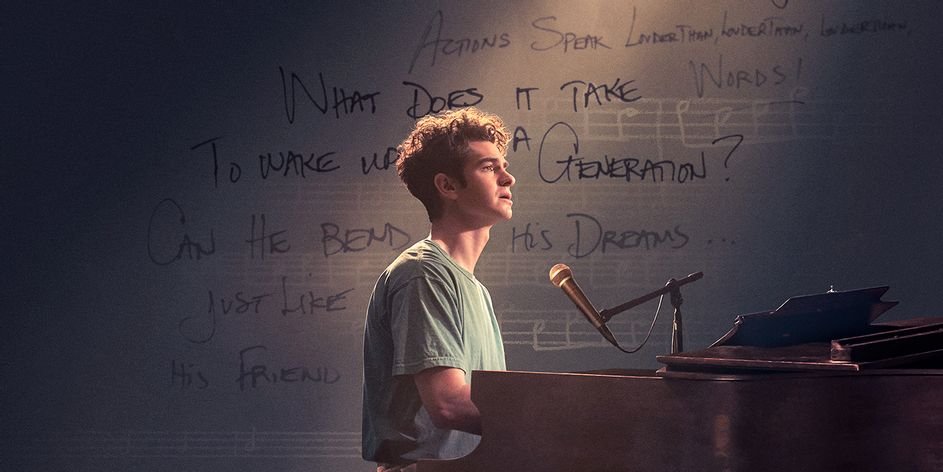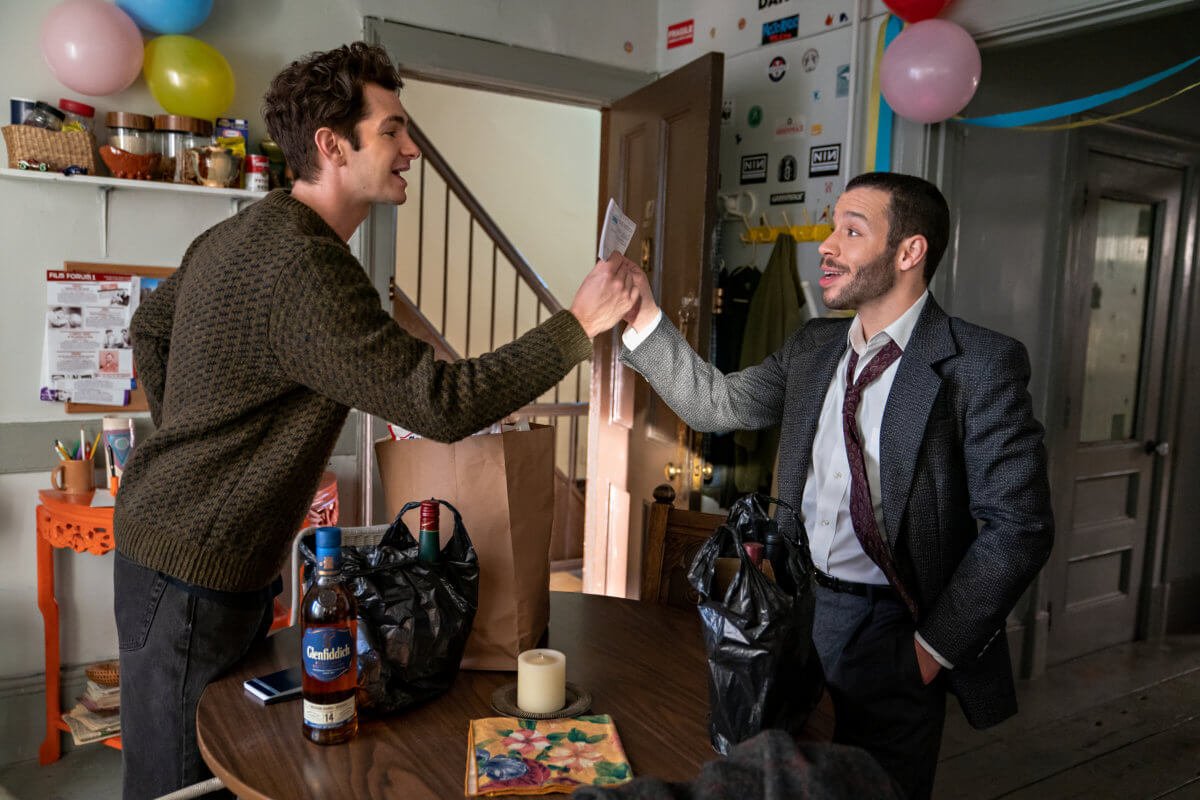'tick, tick...BOOM!' Review: Lin-Manuel Miranda's Directorial Debut is an Electrifying Masterpiece
Andrew Garfield in tick, tick…BOOM!
“I’m the future of musical theatre.”
Broadway: the dazzling marquees, the twinkling lights, the ensembles singing and dancing in unison. Lining the streets between Manhattan’s lower 40th to 50th blocks are the products of dreamers; of artists who took intimate moments from their lives and set them on a stage. Some of the most famous names to ever grace these marquees are the likes of Stephen Sondheim, Rodgers & Hammerstein, George Gershwin, and Cole Porter. Yet a man with some of the fewest credits to his name is another: Jonathan Larson. The inimitable composer of Rent, one of the longest-running and most well-known shows of all time, was tragically taken from the world when he passed away unexpectedly at just age thirty-five on the eve of the first off-Broadway debut of the show. Though he never lived to see the fruits of his own legacy, his influence in modern musical style and storytelling is undeniable.
Who better to bring his story to life than the latest sensation to be added to the aforementioned marquee, Lin-Manuel Miranda? The tour-de-force is most notably known for his Tony-award winning musicals, In the Heights and Hamilton, but Miranda’s swirling love story with musical theatre traces back to his earliest memories. His parents filled his childhood with music of many genres (including hip-hop and Latin music, which influenced Miranda’s own writing style) and a heavy inclusion of music from the theatre. Miranda first saw Rent on his seventeenth birthday and established his own emotional connection with Larson then. Later, at a pivotal point in his educational and creative life, Miranda also saw the off-Broadway adaptation of another one of Larson’s musicals, tick, tick…BOOM! and had his life changed forever. It altered his perception of where he was going in his life, the people he surrounded himself with, and the pressure to beat the clock. So, when the call came for him to direct the film, he knew that he was the only person for the job.
Andrew Garfield in tick, tick…BOOM!
The premise of the film follows Larson—played in a career-best performance by Andrew Garfield—on the verge of his 30th birthday. During the day he works as a waiter in a diner, all the while feeling a metaphorical and, at times, literal “ticking” inside of his mind as the pressure to write the next great American musical builds. Written as semi-autobiographical, it focuses on Larson seeking answers for how he should spend his time, which he was becoming increasingly aware was finite. He asked himself, and thus subsequently challenging his audience to question: what are we to do with this time that we have? How do we make the most of it? How do we make the biggest impact? Larson’s mind was rarely still, and these questions lingering constantly in his mind turned into motivation for his work. Part of the inspiration for the musical came after Larson had spent over six years on another rock musical, Superbia, which was his twist on adapting George Orwell’s famous book, 1984. He got as far as getting it workshopped in front of his hero, Stephen Sondheim. It was well-received and even prompted a letter of recommendation endorsing both Larson and the musical from Sondheim himself. But despite its praise, the feedback ultimately resounded to implying that his work was good, but not quite good enough to stage. This both confused and upset Larson, which led to him questioning his career, his craft, and what was missing to get his work to where he wanted when he knew he was on the right track. And as such, tick, tick…BOOM! was born.
One of Miranda’s greatest and strongest assets as an artist and a creator is that he is a fan before anything. His passion for whatever he invests his time into is integrated so deeply into any given project that the viewer can’t help but to feel connected. This indomitable quality has perhaps never been stronger than now. The film is a love letter to many things: to Jonathan Larson, to musical theatre, to artists, to the unbreakable human spirit. Miranda thoughtfully walks the line between honoring the man that Larson was while simultaneously not being afraid to show the qualities that impeded him, too. He shows him at his best and at his worst, but he shows him truthfully and vulnerably, and combined with Garfield’s incredible commitment to fully embody him, keeps the audience firmly in Larson’s grasp from the very first note. Even when the audience feels frustrated with Larson, it’s impossible not to be rooting for him all the while.
Miranda was also smart in creating a circle of competent and trusted team members around him that helped to create the time capsule of this era. Steven Levenson, the writer, wrote the book for the acclaimed Broadway musical, Dear Evan Hansen and had previously collaborated with Miranda on another Broadway-inspired project, the FX limited series, Fosse/Verdon. The film’s cinematographer, Alice Brooks, had worked with him and director Jon M. Chu on the film adaptation of Miranda’s first musical, In the Heights, and the film’s executive music producer is his long-time collaborator and friend, Alex Lacamoire, who has worked with Miranda on nearly every project over the last decade and a half. Despite having a lifetime working in the arts, this was Miranda’s first time directing a film, but one would hardly know it when watching. Where Miranda would infuse the passion and the deep-seated knowledge of Larson and musical theatre history, the team he built around himself brought the magic to life. Whether it be through the impeccable production design that meticulously re-created Larson’s apartment down to the exact decorations on the wall, the simultaneously sweeping and intimate cinematography that plants the viewer fully in Larson’s New York City, or the profound orchestrations of the music that changed Broadway as everyone had once knew it, this film soars from the heart on every single level.
Andrew Garfield and Robin de Jesus in tick, tick…BOOM!
In keeping with capturing moments from this specific era both in Larson’s life and the rest of the world, the film also delicately and respectfully integrates the AIDS epidemic that was deeply affecting so many in the community. One particular standout moment in the film is when a character named Michael (who was based off one of Larson’s real-life best friends, Matt O’Grady, and is played beautifully by another collaborator of Miranda’s, Robin de Jesus) reveals that he is HIV positive. Michael is Larson’s close friend and roommate, and like Larson, Michael had originally pursued a career in the arts until he was able to find a different, more financially stable path working in advertising. At times, this difference divides the two men as Larson becomes borderline obsessive about becoming a successful composer at virtually any cost. When Larson is too deep in the narrow-minded throes of his work, he begins to unintentionally ignore those around him including his girlfriend, Susan, and Michael. In the gripping scene between the two actors where Michael shares his diagnosis (which again, is a testament to the sublime casting of the film), Larson feels devastated and lost and begins hopelessly running through New York streets and through Central Park. Here, Miranda brilliantly uses an audio motif of a ticking sound, one that builds as Larson’s mind continues to spiral and race, layered with Michael singing a chillingly haunting melody of his own, asking, “Is this real life?” Larson runs until he finds an amphitheater with a single piano. He sits down and begins to play, and with the first note his hand plays, the ticking stops. Here, Garfield as Larson breaks out into a heartbreaking ballad as he reflects on Michael and the critical role he’s played in his life (worth noting, by the way, that Garfield sang this song live on camera which only made the emotion and heartache in his voice that much more palpable). It’s not only a pivotal and transformative moment for the character, with the underlying metaphor being that music is the only thing that can stop the ticking, but it is perhaps the moment where the audience feels the most deeply connected to Larson as he sits in his most natural, yet vulnerable state: just a man, his words, and a piano.
In between the varying musical numbers (which includes a star-studded version of “Sunday,” Larson’s loving and witty take on the Sondheim classic of the same name, altered to be about the Sunday brunch scene at the diner), the film is layered with the many elements weighing heavily on Larson’s mind, including his struggle to choose between moving to the Berkshires to support his girlfriend, Susan (played delicately by the lovely Alexandra Shipp), who is also in the arts, or to stay put and finish the musical. The ultimate conflict of the film is the relationship that Larson must face head-on: his relationship with himself. To be an artist is to make great sacrifice, whether it be at the cost of your sleep, your finances, your desires, or your relationships. The ticking in his mind doesn’t just represent the pressure for his career or the impact to make with his life—it represents the impending expiration of the people around him, whether literally or metaphorically. It is here that Miranda expertly crafts the narrative for this as it is a subject that hits almost too close to home.
Andrew Garfield and Alexandra Shipp in tick, tick…BOOM!
Regardless of whether someone is in the arts or not, Miranda has created a certain accessibility within tick, tick…BOOM! with themes that anyone can relate to. The key to the film’s success is the tender precision and care with which it is handled. Miranda creates a place of warmth, welcoming, understanding, and room for error and growth. He acts not on the specifics of the plot, but rather on the core human emotions of compassion, empathy, love, and desire. He extends his hand out to the audience and asks them to think on our shared communal experience of longing for passion, success, understanding, and acceptance; to challenge and rise against what is expected of us and ask how we can do more. The film is honest without feeling jaded, complicated without feeling convoluted, and ultimately is a pillar of inspiration and a testament to the power of that unbreakable human spirit.
“Cages or wings? Which do you prefer?” Larson croons in the final moments of the film. It’s a question he’s not only asking of the audience sitting in front of him, but a question that he’s asking himself. It serves as a metaphor for the entire film: will we stand in our own way and lock ourselves in, or will we take a leap of faith and see where it takes us? This single question captures the essence of Jonathan Larson perfectly and serves as a reminder that there is a bird waiting to soar inside all of us: we just have to be brave enough to open the door and let it fly.




